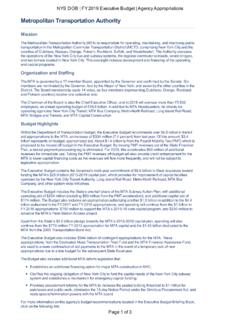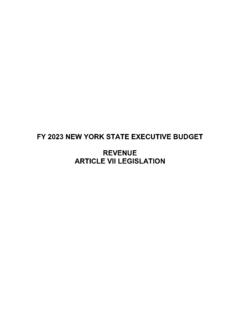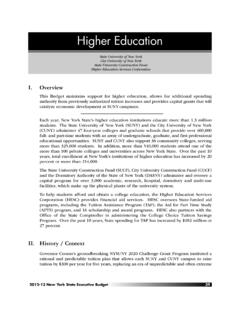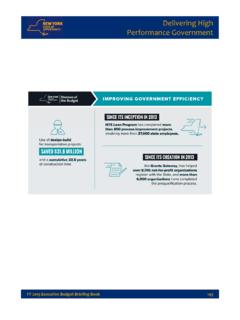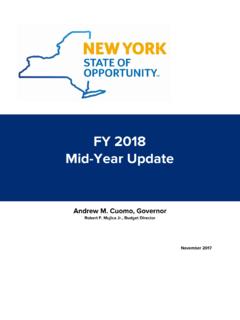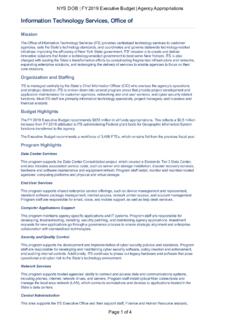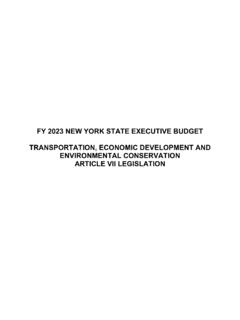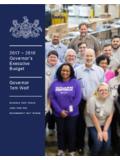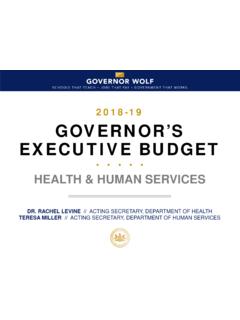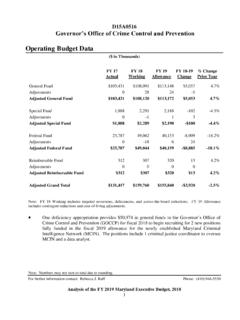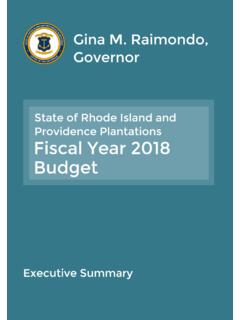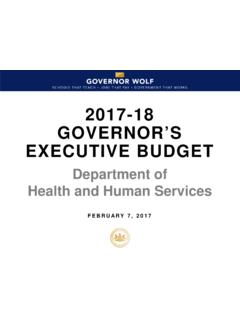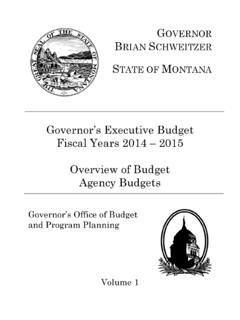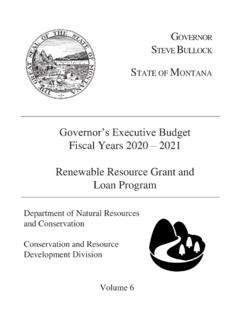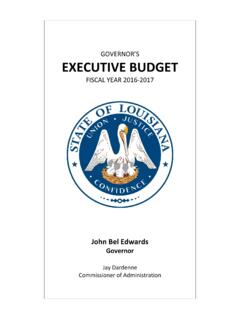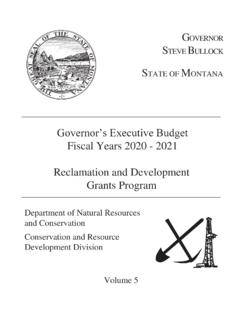Transcription of FY 2019 Executive Budget Financial Plan
1 FY 2019 . Executive Budget Financial plan Updated for governor 's Amendments and Forecast Revisions Andrew M. Cuomo, governor Robert F. Mujica Jr., Budget Director February 2018. Table of Contents Introduction .. 1. Budgetary and Accounting Practices .. 2. Overview of the Financial plan .. 7. Revisions to the Executive Budget Financial plan .. 7. Financial plan At-A-Glance: Key Measures .. 10. Executive Summary ..11. Annual Spending Growth .. 19. General Fund Financial plan .. 25. FY 2018 Financial plan Update .. 25. FY 2019 Financial plan (Compared to FY 2018 Estimates) ..31. Extraordinary Monetary Settlements .. 43. Other Matters Affecting the Financial plan .. 49. State Financial plan Projections Fiscal Years 2018 Through 2022.
2 71. FY 2018 Year-To-Date Operating Results .. 129. Fiscal Impact on Local 139. Glossary of Acronyms .. 143. Financial plan Tables and Accompanying Notes .. 149. Introduction Introduction Introduction The governor submitted his Executive Budget proposal for Fiscal Year (FY) 2019 to the Legislature on January 16, 2018. The Executive Budget Financial plan set forth the multi-year forecast of receipts and projections based on the governor 's proposal. The State Constitution permits the governor to submit amendments to the Executive Budget within 30 days of its constitutional submission date. The governor submitted amendments to the Executive Budget for FY 2019 on February 15, 2018, as permitted by law. This Executive Budget Financial plan for FY 2019 , as amended (the Executive Budget or Financial plan ) updates and summarizes the State of New York's official Financial plan projections for FY 2018 through FY 2022.
3 The projections reflect the estimated impact of the governor 's Executive Budget proposal for FY 2019 , as described herein. The State's FY 2019 will begin on April 1, 2018 and end on March 31, 2019 . The factors affecting the State's Financial condition are complex. This Financial plan contains forecasts, projections and estimates that are based on expectations and assumptions, which existed at the time they were prepared, and contains statements relating to future results and economic performance that are "forward-looking statements" as defined in the Private Securities Litigation Reform Act of 1995. Since many factors may materially affect fiscal and economic conditions in the State, the inclusion in this Financial plan of forecasts, projections, and estimates should not be regarded as a representation that such forecasts, projections, and estimates will occur.
4 The forward-looking statements contained herein are based on the State's expectations and are necessarily dependent upon assumptions, estimates and data that it believes are reasonable as of the date made, but that may be incorrect, incomplete or imprecise or not reflective of actual results. Forecasts, projections, and estimates are not intended as representations of fact or guarantees of results. The words expects , forecasts , projects , intends , anticipates , estimates , assumes and analogous expressions are intended to identify forward-looking statements in this Financial plan . Any such statements inherently are subject to a variety of risks and uncertainties that could cause actual results to differ materially and adversely from those projected.
5 Such risks and uncertainties include, among others, general economic and business conditions; changes in political, social, economic, and environmental conditions, including climate change and extreme weather events; impediments to the implementation of gap-closing actions;. regulatory initiatives and compliance with governmental regulations; litigation; Federal tax law changes; actions by the Federal government to reduce or disallow expected aid, including Federal aid authorized or appropriated by Congress but subject to sequestration, administrative actions, or other actions that would reduce aid to the State; and various other events, conditions and circumstances, many of which are beyond the control of the State.
6 These forward-looking statements are based on the State's expectations as of the date of this Financial plan . The Office of the State Comptroller (OSC) issued the State's Basic Financial Statements for FY 2017 and the Comptroller's Annual Report to the Legislature on State Funds Cash Basis of Accounting. Copies of these reports may be obtained by contacting the Office of the State Comptroller, 110 State Street, Albany, NY 12236 and on its website at The Basic Financial Statements for FY 2017 can also be accessed through the Electronic Municipal Market Access (EMMA) at FY 2019 Executive Budget Financial plan - Updated for governor 's Amendments and Forecast Revisions 1. Introduction Budgetary and Accounting Practices Unless clearly noted otherwise, all Financial information in this Financial plan is presented on a cash basis of accounting.
7 The State's General Fund receives the majority of State taxes and all income not earmarked for a particular program or activity. State law requires the governor to submit, and the Legislature to enact, a General Fund Budget that is balanced. The General Fund is balanced using the cash basis of accounting. The State Constitution and State Finance Law do not provide a precise definition of Budget balance. In practice, the General Fund is considered balanced if sufficient resources are, or are expected to be, available during the fiscal year for the State to: (a) make all planned payments, including Personal Income Tax (PIT) refunds, without the issuance of deficit notes or bonds, or extraordinary cash management actions, (b) restore the balances in the Tax Stabilization Reserve and Rainy Day Reserve to levels at or above the levels on deposit when the fiscal year began, and (c) maintain other reserves, as required by law.
8 For purposes of calculating Budget balance, the General Fund includes transfers to and from other funds. The General Fund is the sole financing source for the School Tax Relief (STAR) fund, and is typically the financing source of last resort for the State's other major funds, which include the Health Care Reform Act (HCRA) funds, the Dedicated Highway and Bridge Trust Fund (DHBTF), the Lottery Fund, and the mental hygiene program and patient income accounts. Therefore, the General Fund projections account for any estimated funding shortfalls in these funds. Since the General Fund is the fund required by law to be balanced, the focus of the State's budgetary and gap-closing discussion in this Financial plan is generally weighted toward the General Fund.
9 From time to time, the Division of the Budget (DOB) will informally designate unrestricted balances in the General Fund for specific policy goals ( , the payment of costs related to potential labor contracts covering prior contract periods). These amounts are typically identified with the phrase reserved for, and are not held in distinct accounts within the General Fund and may be used for other purposes. State Operating Funds is a broader measure of spending for operations (as distinct from capital purposes) that is funded with State resources. It includes Financial activity in the General Fund, as well as State-funded special revenue funds and debt service funds (spending from capital project funds and Federal funds is excluded).
10 As a significant amount of Financial activity occurs in funds outside of the General Fund, State Operating Funds is, in DOB's view, a more comprehensive measure of State-funded activities for operating purposes that are funded with State resources ( , taxes, assessments, fees and tuition). The State Operating Funds perspective is intended to reduce certain distortions in operating activities that may be caused by, among other things, the State's complex fund structure, the transfer of money among funds, and the accounting of disbursements against appropriations in different funds. For example, the State funds its share of the Medicaid program from both the General Fund and HCRA funds, the latter being State Special Revenue Funds.

